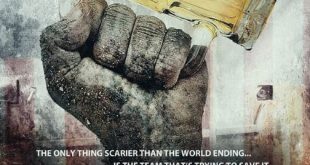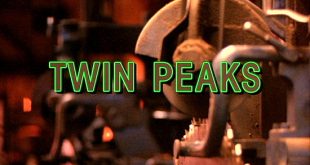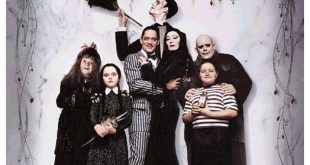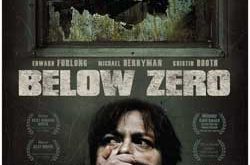 SYNOPSIS:
SYNOPSIS:
“Following Kirk’s encounter with Khan that left the Enterprise severely damaged and Spock dead, they return to Starfleet so that Enterprise could be repaired. Kirk’s hoping to go back to the newly-created Genesis planet where he laid Spock to rest. But upon arriving, he is told that the Enterprise will not be repaired and that Genesis has become a delicate matter and until it is resolved, no one is allowed to go there or talk about it. McCoy is also acting strangely and is later detained when he starts talking about Genesis. Kirk is visited by Spock’s father Sarek, who tells him that he betrayed Spock because being placed on Genesis was not what he would have wanted. He tells Kirk he is supposed to bring Spock’s body along with his soul or katra as the Vulcans call it which he passes onto someone, and bring it to Vulcan for the final rites. Sarek assumes Kirk would have it but he does not. Kirk then thinks that Spock may have passed it someone else and realizes McCoy is the one who has which is why he is acting weird. Sarek tells Kirk he must bring both Spock’s body and McCoy who has his soul to Vulcan so that they could be at peace. Kirk asks permission but his request is refused. Kirk then along with the others decides to take the Enterprise and proceed to Genesis to get Spock’s body. But what they do not know is that the Klingons, who upon learning of Genesis, sets out to get it, so they go there and destroy the science vessel sent to evaluate Genesis. They capture Lieutenant Saavik and Kirk’s son David who go to the planet and discover that Spock was somehow regenerated and that the planet is aging rapidly.” (courtesy IMDB)
REVIEW:
Star Trek II The Wrath Of Khan (1982) was a critical and commercial success, and Paramount Pictures quickly prepared for a third film inspired by the classic Star Trek television series of the sixties. Nicholas Meyer refused to return as director due to disagreements concerning changes made to his film’s ending without his consent. After killing off his character in Wrath Of Khan, Leonard Nimoy became terribly excited about playing Spock once again, and studio chief Michael Eisner asked Nimoy what it would take to bring Spock back in a third film, to which he responded, “I want to direct that picture!” So producer Harve Bennett did something no other Hollywood executive would ever be prepared to do – he hired a director he couldn’t fire. Nimoy wanted his film to be operatic in scope with broad emotions, life-and-death themes, and larger-than-life characters playing out an epic story on a giant canvas. The script for Star Trek III The Search For Spock (1984) was completed in six weeks by Bennett and assigned a budget of US$16 million, a little more expensive than Wrath Of Khan but a lot cheaper than Star Trek The Motion Picture (1979). Since many of the sets and uniforms were recycled from Wrath Of Khan, more money was available for special effects.
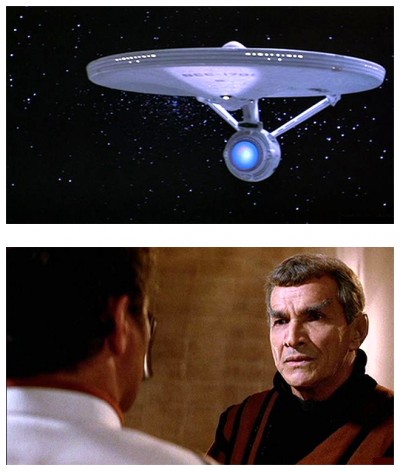 Commander James T. Kirk (William Shatner) is without his logical side, now that Spock is dead. Kirk’s emotional side – personified by Doctor McCoy (DeForest Kelley) who feels guilty for the Vulcan’s death and is beginning to exhibit some of Spock’s mannerisms – now has free reign. So Kirk takes drastic action to try and bring his dear friend back to life…in one form or another. With the help of his trusty crew (Nichelle Nichols, James Doohan, George Takei, Walter Koenig) he disobeys his superiors and steals away with the decommissioned starship Enterprise, heading for the newly formed Genesis planet, where he left Spock’s body. Klingons (who reveal previously unseen personality traits) and the self-destructing Genesis planet make it appear that all will perish. In some ways an improvement over the first two films, Star Trek III The Search For Spock is actually a lovely science-fiction fantasy: it illustrates the excitement of space travel and adventure; it utilises the fantastic premise of resurrecting Spock with the help of the Genesis device; it contemplates mankind’s place in the universe.
Commander James T. Kirk (William Shatner) is without his logical side, now that Spock is dead. Kirk’s emotional side – personified by Doctor McCoy (DeForest Kelley) who feels guilty for the Vulcan’s death and is beginning to exhibit some of Spock’s mannerisms – now has free reign. So Kirk takes drastic action to try and bring his dear friend back to life…in one form or another. With the help of his trusty crew (Nichelle Nichols, James Doohan, George Takei, Walter Koenig) he disobeys his superiors and steals away with the decommissioned starship Enterprise, heading for the newly formed Genesis planet, where he left Spock’s body. Klingons (who reveal previously unseen personality traits) and the self-destructing Genesis planet make it appear that all will perish. In some ways an improvement over the first two films, Star Trek III The Search For Spock is actually a lovely science-fiction fantasy: it illustrates the excitement of space travel and adventure; it utilises the fantastic premise of resurrecting Spock with the help of the Genesis device; it contemplates mankind’s place in the universe.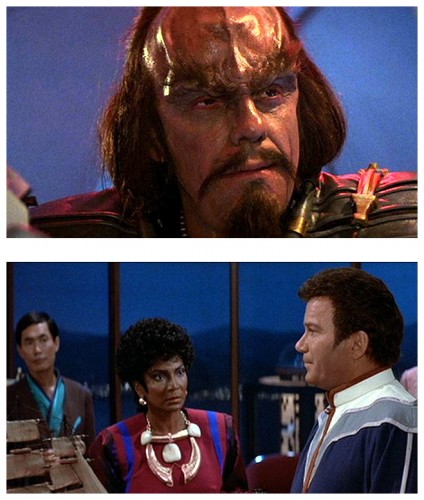
It also forces the well-known characters to at last articulate how they truly feel about each other. After three television seasons and two movies, the characters’ suppressed affection for one another was getting a little too much, but here they are finally allowed to open up, touch each other, hug, kiss, cry, to forget their Starfleet hierarchy and act as a team on equal terms. They aren’t soldiers anymore, they’re human beings. The reason for the emphasis on emotions rather than special effects is due to Nimoy’s work as director – he was fed-up with the coldness that dominated the relationships of the characters in the past – even McCoy now admits he has a soft spot for Spock. It also has a superior supporting cast that includes Mark Lenard, Christopher Lloyd, John Larroquette, Miguel Ferrer, James Sikking, Phil Morris and veteran Hollywood actress Dame Judith Anderson. With the perspective of three decades since the release of Star Trek III The Search For Spock (1984) we can judge this film on its own merits and on how well it fits alongside its predecessor Star Trek II The Wrath Of Khan (1982) and its sequel Star Trek IV The Voyage Home (1986). More importantly, we can now see how the so-called Genesis Trilogy works as a whole. The first thing to remember when discussing the Star Trek trilogy is that no such thing was ever intended in the first place. Wrath Of Khan was clearly meant to stand on its own as the first in a rebooted series of Star Trek films. What changed those plans was, of course, Nimoy’s decision to return as Spock in a third film.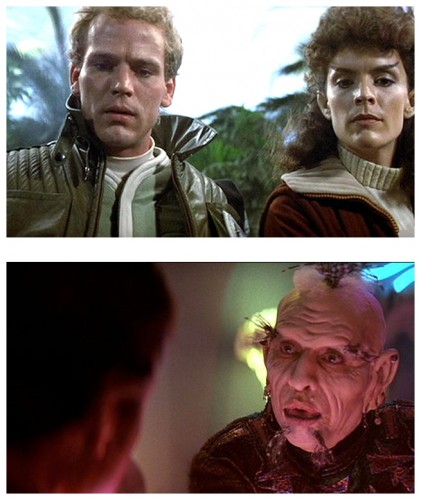
There had been no solid reports of a Star Trek film without Spock but, if there had been, they were immediately scrapped upon Nimoy’s hiring. The next film, unavoidably, had to be the story of Spock’s restoration to life. It was made plain to all that there would be a forthcoming film, and it definitely would be the third in the series, which would follow the second not only in numbering, but in story-line. This decision would not only define (and confine) the subject matter of the third film, but it would also weaken the impact of Wrath Of Khan as a film experience. After all, how much does Spock’s great sacrifice mean when we know he’s going to be found safe-and-sound down there on that Genesis planet? Wrath Of Khan was a beautifully constructed film with an exciting and heartrending climax and an ending that evoked both sadness and hope. We may have lost Spock, but gained a fully matured Kirk in the process, as well as two members of the next generation: Doctor David Marcus (Merritt Butrick) and the redoubtable Saavik (Robin Curtis substituting for Kirstie Alley). All three of these were, in varying ways, snatched from us in the third installment and, as if to rub salt into the wound, we didn’t even get an entire Spock back in exchange.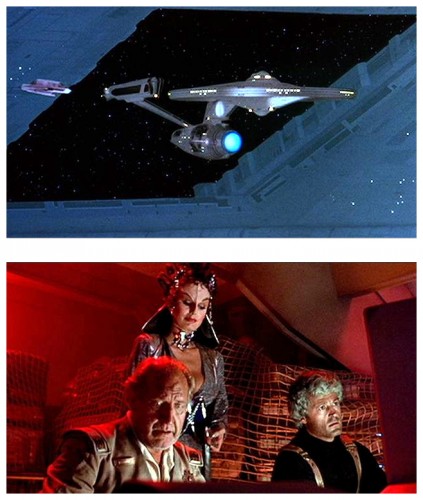
The events that produced Search For Spock as something of an afterthought to Wrath Of Khan were unique, and Paramount is not completely at fault. What can be laid at their feet is blame for the events of the third movie, a scenario so unashamedly contrived to lead into yet another movie as to boggle the mind and test the loyalty of even the staunchest fan. Search For Spock left us with not one, but three elements needing resolution in a fourth film: 1. The trial of Kirk; 2. The loss of the Enterprise; 3. The restoration of Spock’s memory and personality. I’m not saying Search For Spock is a bad film – far from it – but it would have been better to have the events nicely wrapped up at the end, allowing for a fresh story-line in the fourth film. It is insulting to both fans and mainstream film-goers alike to be conned into attending another film just to learn the outcome of events in the previous film. One might argue that such a ploy worked successfully for Back To The Future II (1989) and Back To The Future III (1990) but there’s one big difference: the Back To The Future films had completed screenplays with intricate story arcs for both movies written and filmed together, but the nearsighted producers of Star Trek refused to even consider scripting a fourth film until after Search For Spock was released.
 Perhaps the most annoying fact about this trilogy is that each of the two sequels manage to trivialise the events of the film preceding it. In Wrath Of Khan we saw the death of Spock, the redemption of Kirk, and the creation of the ultimate weapon. In Search For Spock we see Kirk return to his rash obsessive behaviour, and Spock is resurrected by an accident of magnetic fields and forbidden science (the same science that made Genesis work in the first place). There’s also the death of David Marcus, the ordeal of McCoy, and the fiery destruction of our beloved starship Enterprise. In The Voyage Home, David’s death is relegated to an afterthought, McCoy’s questions about death are shrugged aside, and the crew are presented with a brand spanking new Enterprise. Despite its many problems, the trilogy still works pretty well as a whole. In some areas, especially as an examination of growth and change in Kirk and Spock, the trilogy works very well indeed. In other areas, specifically ‘science’, it doesn’t work at all.
Perhaps the most annoying fact about this trilogy is that each of the two sequels manage to trivialise the events of the film preceding it. In Wrath Of Khan we saw the death of Spock, the redemption of Kirk, and the creation of the ultimate weapon. In Search For Spock we see Kirk return to his rash obsessive behaviour, and Spock is resurrected by an accident of magnetic fields and forbidden science (the same science that made Genesis work in the first place). There’s also the death of David Marcus, the ordeal of McCoy, and the fiery destruction of our beloved starship Enterprise. In The Voyage Home, David’s death is relegated to an afterthought, McCoy’s questions about death are shrugged aside, and the crew are presented with a brand spanking new Enterprise. Despite its many problems, the trilogy still works pretty well as a whole. In some areas, especially as an examination of growth and change in Kirk and Spock, the trilogy works very well indeed. In other areas, specifically ‘science’, it doesn’t work at all.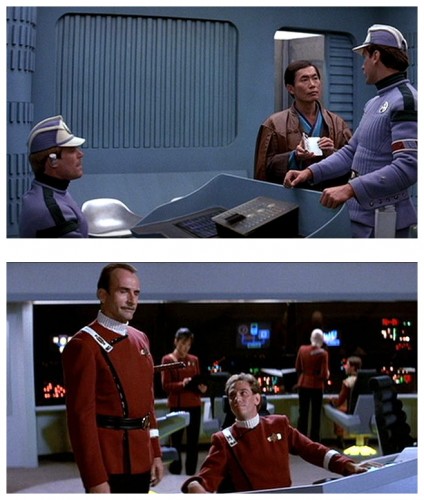
One of the weakest points of the entire trilogy is the science involved. We are asked in Wrath Of Khan to accept the existence of the Genesis device, and we can, thanks to the existence of transporter technology and other well-established Star Trek devices. But then we are also asked to believe that veteran Starfleet officers can mistake one planet for another, which has exploded! Things get even worse in Search For Spock. First, Genesis is simply dismissed by David’s admission that he used ‘protomatter’ to make it work. Are we to believe he slipped this by his mother and the other scientists in the project? And even if he did, the fact still does not invalidate the existence of Genesis, nor would it keep it from being used as a horrific weapon. Indeed, since Genesis can no longer be used to create life, it remains only a weapon of mass destruction, and therefore becomes even more terrible. Search For Spock also asks us to believe that Spock’s body was somehow regenerated as an infant, his body then aging in sync with the death throes of the planet. There are so many reasons why this is not feasible it is not really worth discussing. All we can do is shrug it off and chalk it up as the first step into the fantasy world that the fourth film inhabits.
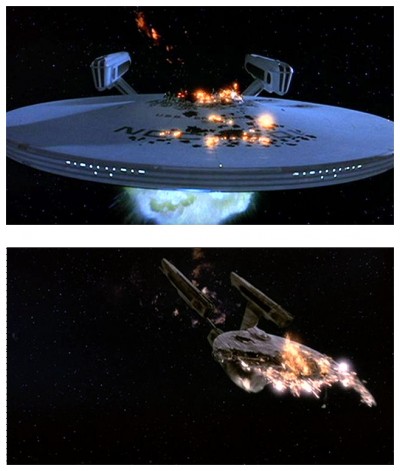 The Voyage Home cannot even remotely be connected with Star Trek science as we know it. The most glaring error is the crew’s cavalier treatment of time travel and incautious tampering with history, but the weather changes caused by the probe’s communications are a little hard to swallow as well. Suffice to say that The Voyage Home verges slightly on the side of the fantastic, and leave it at that. However, it’s impossible to leave it at that when viewing all three films as a whole. As the science becomes more and more arcane and unbelievable in each succeeding movie, one’s willing suspension of disbelief is strained to the breaking point. I can accept Genesis and time travel, but I have difficulty accepting double-talk about protomatter or Scotty and Kirk playing fast and loose with established history. But that’s another story for another time. Right now I’d like to profusely thank Trek magazine edited by Walter Irwin and G.B. Love for assisting my research for this article, then I’ll make my fond farewells, but please be sure to return next week with a stout heart, an iron stomach and a titanium bladder for another head-melting romp through the garden of unearthly delights known as…Horror News! Toodles!
The Voyage Home cannot even remotely be connected with Star Trek science as we know it. The most glaring error is the crew’s cavalier treatment of time travel and incautious tampering with history, but the weather changes caused by the probe’s communications are a little hard to swallow as well. Suffice to say that The Voyage Home verges slightly on the side of the fantastic, and leave it at that. However, it’s impossible to leave it at that when viewing all three films as a whole. As the science becomes more and more arcane and unbelievable in each succeeding movie, one’s willing suspension of disbelief is strained to the breaking point. I can accept Genesis and time travel, but I have difficulty accepting double-talk about protomatter or Scotty and Kirk playing fast and loose with established history. But that’s another story for another time. Right now I’d like to profusely thank Trek magazine edited by Walter Irwin and G.B. Love for assisting my research for this article, then I’ll make my fond farewells, but please be sure to return next week with a stout heart, an iron stomach and a titanium bladder for another head-melting romp through the garden of unearthly delights known as…Horror News! Toodles!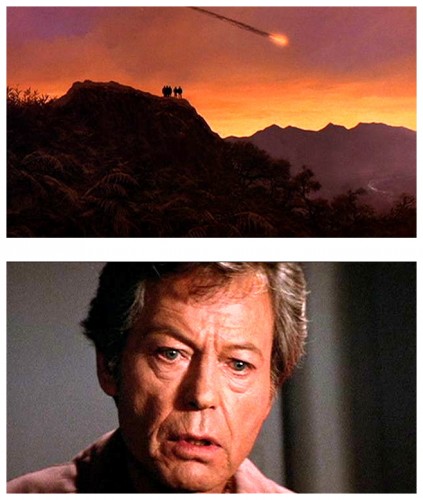
Star Trek III The Search For Spock (1984)
 Horror News | HNN Official Site | Horror Movies,Trailers, Reviews
Horror News | HNN Official Site | Horror Movies,Trailers, Reviews


